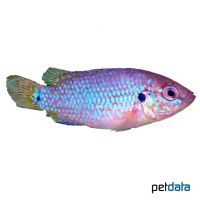Lifalili Cichlid Blue (Hemichromis lifalili 'Blue')
| Lifalili Cichlid Blue Hemichromis lifalili 'Blue' | |
|---|---|
| Name | Lifalili Cichlid Blue |
| Name Lat. | Hemichromis lifalili 'Blue' |
| Family | Cichlids |
| Family lat. | Cichlidae |
| Order | Cichlids |
| Order lat. | Cichliformes |
| Origin | Africa |
| Habitat | Streams, rivers, lakes |
| Diet | Carnivore |
| pH | 6.0-7.8 |
| Behavior | Semi-aggressive |
| Keeping | Pair |
| Care Level | Moderate |
| Reproduction | Substrate spawner |
| Breeding | Difficult |
| Life Span | 5-8 years |
| Protection | No |
| Metric Units | |
| Size | 8-10 cm |
| Temperature | 22-26 °C |
| Hardness | 4-15 °dH |
| Aquarium | 200 l |
| US Units | |
| Size | 3.1"-3.9" |
| Temperature | 72-79 °F |
| Hardness | 71-267 ppm |
| Aquarium | 50 gal |
Distribution and habitat
The Blue Lifalilis cichlid is a breeding form. The Hemichromis lifalili are widespread in Central Africa, in the Congo River basin. There they live in slow flowing streams and small rivers as well as in oxygen rich lakes and ponds with sandy bottoms, roots and stones
Maintenance
The aquarium should be equipped with hiding places (crevices and caves) from stones and roots, as well as robust planting. A soft, diggable substrate and slightly subdued light (floating plants) and oxygen-rich water is ideal
No ammonia, ammonium or nitrite should be detectable, and the nitrate value should not exceed 100 mg/l. To ensure the water quality and oxygen content, a filter and heater adapted to the aquarium size is required, as well as lighting for the species-appropriate day-night rhythm of the animals.
Diet
The food supply consists of live, frozen and dry food. For a balanced diet, feed once a day with a high-quality dry food for cichlids (flakes, granules, pellets) as well as daphnia, artemia, tubifex, mosquito larvae or mysis (live or frozen). In addition, they need some vegetable food, such as blanched spinach, algae leaves or dry food with vegetable ingredients (e.g. spirulina)
Only feed as much as will be eaten within a few minutes. A regular and varied diet promotes health and prevents deficiency symptoms.
Behaviour and compatibility
They must be maintained in pairs. Especially at spawning time they behave extremely aggressive. Keeping several pairs is only recommended in a much larger and richly structured tank. They can be socialized with larger African tetras and cichlids as well as catfishes (e.g. Synodontis, Loricaria).
Basically, only compatible fish species with similar demands on water condition and water temperature should be socialized.
Sex dimorphism
The sexes are difficult to distinguish. The males are slightly more intensely colored than the females.
Reproduction and breeding
They are substrate spawners and practice intensive brood care (parental family). Once a harmonizing pair has been found, the female usually spawns up to 400 eggs on a well-cleaned, smooth stone. After about 48 hours, the fry hatch and are then housed by the parents in a bottom pit until they swim freely after another 2-3 days. The fry are intensively guarded by both parents and led to other prepared bottom pits before brood care ends after about 4 weeks.
Fry must be fed several times a day with special rearing food (Artemia nauplii). In community tanks breeding is hardly possible, because the fry are easy prey.
Important
Feeding live food promotes the color intensity of the fish.
The well-being of the fish should be checked regularly. The temperature should be checked daily, the pH, hardness and nitrate value at least every 14 days. Regular partial water changes are recommended, even if the contaminant level has not yet reached the upper limit. Sudden changes in water quality should be avoided. Newly introduced fish must be accustomed slowly to the water in the aquarium.
Further literature can be found in your pet store.
References
Text: petdata; Image: petdata
Source: BMELV (1998): Tierschutzgutachten - Haltung von Zierfischen (Süßwasser); RIEHL & BAENSCH (2006): Aquarien Atlas Bd. 1, Mergus Verlag; ENGELMANN (2005): Zootierhaltung - Tiere in menschlicher Obhut: Fische, Verlag Harri Deutsch
- Gemäß § 21 Abs. 5 Tierschutzgesetz idgF
